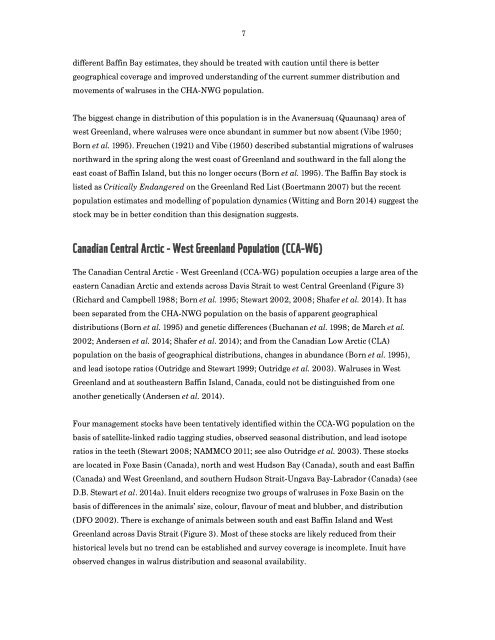The State of Circumpolar Walrus Populations
walrusreport
walrusreport
You also want an ePaper? Increase the reach of your titles
YUMPU automatically turns print PDFs into web optimized ePapers that Google loves.
7<br />
different Baffin Bay estimates, they should be treated with caution until there is better<br />
geographical coverage and improved understanding <strong>of</strong> the current summer distribution and<br />
movements <strong>of</strong> walruses in the CHA-NWG population.<br />
<strong>The</strong> biggest change in distribution <strong>of</strong> this population is in the Avanersuaq (Quaunaaq) area <strong>of</strong><br />
west Greenland, where walruses were once abundant in summer but now absent (Vibe 1950;<br />
Born et al. 1995). Freuchen (1921) and Vibe (1950) described substantial migrations <strong>of</strong> walruses<br />
northward in the spring along the west coast <strong>of</strong> Greenland and southward in the fall along the<br />
east coast <strong>of</strong> Baffin Island, but this no longer occurs (Born et al. 1995). <strong>The</strong> Baffin Bay stock is<br />
listed as Critically Endangered on the Greenland Red List (Boertmann 2007) but the recent<br />
population estimates and modelling <strong>of</strong> population dynamics (Witting and Born 2014) suggest the<br />
stock may be in better condition than this designation suggests.<br />
Canadian Central Arctic - West Greenland Population (CCA-WG)<br />
<strong>The</strong> Canadian Central Arctic - West Greenland (CCA-WG) population occupies a large area <strong>of</strong> the<br />
eastern Canadian Arctic and extends across Davis Strait to west Central Greenland (Figure 3)<br />
(Richard and Campbell 1988; Born et al. 1995; Stewart 2002, 2008; Shafer et al. 2014). It has<br />
been separated from the CHA-NWG population on the basis <strong>of</strong> apparent geographical<br />
distributions (Born et al. 1995) and genetic differences (Buchanan et al. 1998; de March et al.<br />
2002; Andersen et al. 2014; Shafer et al. 2014); and from the Canadian Low Arctic (CLA)<br />
population on the basis <strong>of</strong> geographical distributions, changes in abundance (Born et al. 1995),<br />
and lead isotope ratios (Outridge and Stewart 1999; Outridge et al. 2003). <strong>Walrus</strong>es in West<br />
Greenland and at southeastern Baffin Island, Canada, could not be distinguished from one<br />
another genetically (Andersen et al. 2014).<br />
Four management stocks have been tentatively identified within the CCA-WG population on the<br />
basis <strong>of</strong> satellite-linked radio tagging studies, observed seasonal distribution, and lead isotope<br />
ratios in the teeth (Stewart 2008; NAMMCO 2011; see also Outridge et al. 2003). <strong>The</strong>se stocks<br />
are located in Foxe Basin (Canada), north and west Hudson Bay (Canada), south and east Baffin<br />
(Canada) and West Greenland, and southern Hudson Strait-Ungava Bay-Labrador (Canada) (see<br />
D.B. Stewart et al. 2014a). Inuit elders recognize two groups <strong>of</strong> walruses in Foxe Basin on the<br />
basis <strong>of</strong> differences in the animals’ size, colour, flavour <strong>of</strong> meat and blubber, and distribution<br />
(DFO 2002). <strong>The</strong>re is exchange <strong>of</strong> animals between south and east Baffin Island and West<br />
Greenland across Davis Strait (Figure 3). Most <strong>of</strong> these stocks are likely reduced from their<br />
historical levels but no trend can be established and survey coverage is incomplete. Inuit have<br />
observed changes in walrus distribution and seasonal availability.


